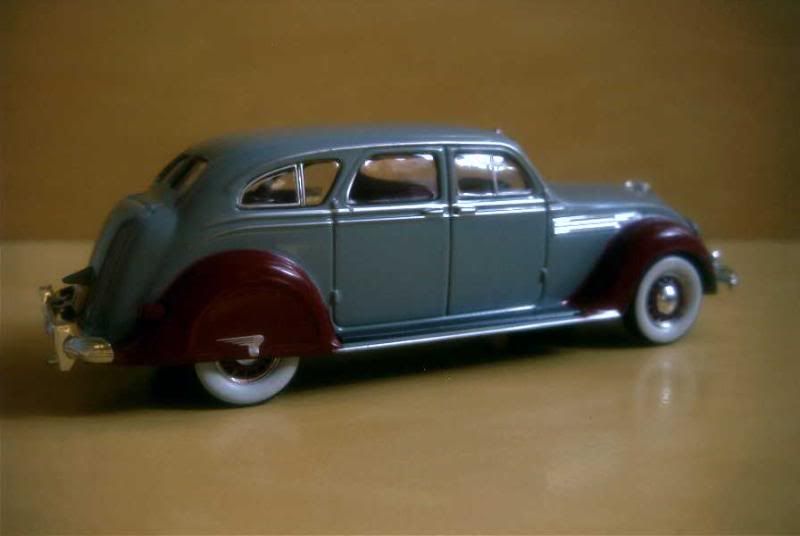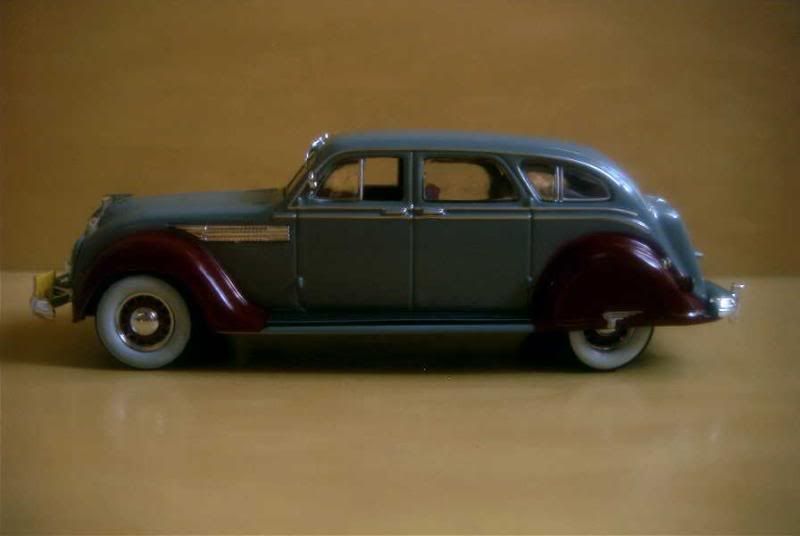A little history
Up to the early Thirties, the pace of change for automobile look wasn’t a fast one. Then engineers and designers discovered aerodynamics, known at first as streamlining: an empirical form of the former, a simple gimmick aimed at appealing customers in an era which was constantly projecting itself into the future. Within a few years though, the approach to aerodynamics applied to automobiles became more scientific, at least for a handful of carmakers.
The period certainly astonished many a motorist. Cars were becoming outdated within a few years due to constant innovation, which along the way brought some odd designs. Among those, the Chrysler Airflow was surely the most forward-looking. Equally certain was the fact that when it first appear in 1934, it looked like nothing else on the road.
A large corporation in the absolute but a minor contender when compared to General Motors and Ford, Chrysler had no other option throughout its history than challenge its competitors on the field of innovation. The company had just been able to adapt to its own cars the low silhouettes of front-wheel-drive models pioneered by Cord and Ruxton when it presented a truly ground-breaking automobile, the Airflow, brainchild of Chrysler engineer Carl Breer, helped by chief stylist Oliver Clark and fully supported by Walter P. Chrysler himself. A patient study of the evolutions of a car through air, thanks to a purposely-built wind tunnel, was the first step in the Airflow design. Yet the futuristic character of the new Chrysler wasn’t only on the outside. The car was among the very first to adopt all-steel monocoque construction, decades ahead of rivals GM and Ford, and weight balance was carefully studied, ideal distribution being attained by moving the engine over the front wheels.
The Chrysler Airflow was unveiled in 1934 to an amazed public. The new car was low and sleek. The rear wheel arches were skirted, while its windshield was of a new “V” type made of two panes of flat glass. Headlights were mounted flush in the front wings, while the upright front end had given way to a rounded one, ornate with a large “waterfall” grille. The first road tests revealed a safe car, with a handling far superior to any of its rivals, thanks to the good weight distribution mentioned above. Next to the Chrysler Airflow range sat its smaller relative, the DeSoto Airflow, while Dodge and Plymouth had to content themselves with conventional models – on the long run, they had nothing to regret.
Potential customers were surprised, curious, even interested, but then came to their mind the fateful question traditionally brought by automotive projects too much ahead of their times: “Do I want to be seen driving such a thing?” All too often the answer was “no”, and initially sales were slow. The people at Chrysler weren’t alarmed. They knew their car was revolutionary, and expected its success to come progressively. Unfortunately, it never did.
Nineteen thirty-four proved disastrous for Chrysler and DeSoto. While the former had retained a limited range of conventional cars, the latter only relied on the new Airflow, and saw its sales take a plunge, a debacle from which it never really recovered until the brand was discontinued a quarter of a century later. For 1935, a new Airstream was introduced by both divisions. It was a fairly conventional car, but featured apparent streamlining. This shier approach attracted the public back into Chrysler’s showrooms and dealerships, at the expense of the Airflow which, despite a 1936 facelift mostly aimed at removed the criticized grille, saw its production numbers sink ever deeper. The DeSoto Airflow was retired after the 1936 model year, while its Chrysler counterpart survived for one more year. They had nonetheless paved the way for more successful imitators, which ironically had begun to appear even before the Airflow project was put to death. Among those who copied the Airflow outright, the most obvious are Volvo (with its Carioca), Peugeot (the 402), Toyota (the AA) and, seldom mentioned but indisputably Airflow-esque, Nash (the Ambassador).
About the model
Model: Chrysler Airflow Imperial Eight
Year: 1936
Maker: Ixo
Scale: 1/43
Distributed by: Altaya as no.49 of its Voitures Classiques press series
Acquired: brand new, in November 2007, in Souillac, France
To my utter disbelief Ixo and Altaya didn’t choose the revolutionary 1934 Airflow to include in their classic cars series, but the tamer 1936 version. This little disappointment set aside this Airflow is rather good, though two-tone paint is surprising as most Airflows, should they be original cars or restored ones, are painted in simpler solid colours. My main remark would aim at the “chrome” parts (grille and louvres in particular), which are much too plastic-like in appearance. My rating is 12/20.




Up to the early Thirties, the pace of change for automobile look wasn’t a fast one. Then engineers and designers discovered aerodynamics, known at first as streamlining: an empirical form of the former, a simple gimmick aimed at appealing customers in an era which was constantly projecting itself into the future. Within a few years though, the approach to aerodynamics applied to automobiles became more scientific, at least for a handful of carmakers.
The period certainly astonished many a motorist. Cars were becoming outdated within a few years due to constant innovation, which along the way brought some odd designs. Among those, the Chrysler Airflow was surely the most forward-looking. Equally certain was the fact that when it first appear in 1934, it looked like nothing else on the road.
A large corporation in the absolute but a minor contender when compared to General Motors and Ford, Chrysler had no other option throughout its history than challenge its competitors on the field of innovation. The company had just been able to adapt to its own cars the low silhouettes of front-wheel-drive models pioneered by Cord and Ruxton when it presented a truly ground-breaking automobile, the Airflow, brainchild of Chrysler engineer Carl Breer, helped by chief stylist Oliver Clark and fully supported by Walter P. Chrysler himself. A patient study of the evolutions of a car through air, thanks to a purposely-built wind tunnel, was the first step in the Airflow design. Yet the futuristic character of the new Chrysler wasn’t only on the outside. The car was among the very first to adopt all-steel monocoque construction, decades ahead of rivals GM and Ford, and weight balance was carefully studied, ideal distribution being attained by moving the engine over the front wheels.
The Chrysler Airflow was unveiled in 1934 to an amazed public. The new car was low and sleek. The rear wheel arches were skirted, while its windshield was of a new “V” type made of two panes of flat glass. Headlights were mounted flush in the front wings, while the upright front end had given way to a rounded one, ornate with a large “waterfall” grille. The first road tests revealed a safe car, with a handling far superior to any of its rivals, thanks to the good weight distribution mentioned above. Next to the Chrysler Airflow range sat its smaller relative, the DeSoto Airflow, while Dodge and Plymouth had to content themselves with conventional models – on the long run, they had nothing to regret.
Potential customers were surprised, curious, even interested, but then came to their mind the fateful question traditionally brought by automotive projects too much ahead of their times: “Do I want to be seen driving such a thing?” All too often the answer was “no”, and initially sales were slow. The people at Chrysler weren’t alarmed. They knew their car was revolutionary, and expected its success to come progressively. Unfortunately, it never did.
Nineteen thirty-four proved disastrous for Chrysler and DeSoto. While the former had retained a limited range of conventional cars, the latter only relied on the new Airflow, and saw its sales take a plunge, a debacle from which it never really recovered until the brand was discontinued a quarter of a century later. For 1935, a new Airstream was introduced by both divisions. It was a fairly conventional car, but featured apparent streamlining. This shier approach attracted the public back into Chrysler’s showrooms and dealerships, at the expense of the Airflow which, despite a 1936 facelift mostly aimed at removed the criticized grille, saw its production numbers sink ever deeper. The DeSoto Airflow was retired after the 1936 model year, while its Chrysler counterpart survived for one more year. They had nonetheless paved the way for more successful imitators, which ironically had begun to appear even before the Airflow project was put to death. Among those who copied the Airflow outright, the most obvious are Volvo (with its Carioca), Peugeot (the 402), Toyota (the AA) and, seldom mentioned but indisputably Airflow-esque, Nash (the Ambassador).
About the model
Model: Chrysler Airflow Imperial Eight
Year: 1936
Maker: Ixo
Scale: 1/43
Distributed by: Altaya as no.49 of its Voitures Classiques press series
Acquired: brand new, in November 2007, in Souillac, France
To my utter disbelief Ixo and Altaya didn’t choose the revolutionary 1934 Airflow to include in their classic cars series, but the tamer 1936 version. This little disappointment set aside this Airflow is rather good, though two-tone paint is surprising as most Airflows, should they be original cars or restored ones, are painted in simpler solid colours. My main remark would aim at the “chrome” parts (grille and louvres in particular), which are much too plastic-like in appearance. My rating is 12/20.







No comments:
Post a Comment